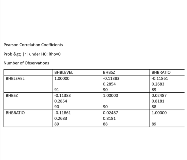Correlation Between Blood Ketone Level Beta-hydroxybutyrate (BHB) and Seizure Frequency in Children With Epilepsy Treated With the Classic Ketogenic Diet
Abstract number :
3.369
Submission category :
10. Dietary Therapies (Ketogenic, Atkins, etc.)
Year :
2018
Submission ID :
505891
Source :
www.aesnet.org
Presentation date :
12/3/2018 1:55:12 PM
Published date :
Nov 5, 2018, 18:00 PM
Authors :
Breanne Fisher, Lurie Children's Hospital of Chicago; Jacqueline Wolak, Lurie Children's Hospital of Chicago; Robyn Blackford, Lurie Children's Hospital of Chicago; Wesley Lowman, Lurie Children's Hospital of Chicago; Emily Golbeck, Lurie Children's Hospi
Rationale: The classic ketogenic diet (KD) is a proven treatment to reduce seizures in children and adults withpharmacoresistant epilepsy. It is often used as an add-on therapy with anti-seizure medications (ASM) and issupervised by trained medical specialists and dietitians. The classic KD has been shown in many studies to be particularly helpful for children with epilepsy, however little research has been done to confirm a positivecorrelation between seizure frequency and the routinely monitored blood ketone level beta-hydroxybutyrate(BHB). We examined the relationships between seizure response, ketogenic diet ratio and BHB to determinewhether BHB or ratio was a better predictor of seizure response to the diet. Methods: We retrospectively reviewed data from 30 patients from our epilepsy center who initiated treatment with classic KD between 4/2013-12/2017. We routinely collect blood BHB levels at every visit and record both seizure frequency and diet ratio at time of blood draw. Our practice is to discharge patients from the hospital on a target ratio=3:1. Seizure frequency was quantified since last visit: none, 1 isolated seizure, 1-4/month, 1-5/week, ~1/day, 2-10/day, >10/day based on parental report. Epilepsy syndromes and etiologies were identified on the basis of the medical record. To test our hypothesis, we focused only on children who had at least a partial response to classic KD (sustained change of 2 or more categories in seizure frequency). Analyses were performed using t-tests and correlations as well as mixed model regression to adjust for multiple observations per patient. Results: Thirty patients initiated the classic KD during this time and were followed for 2-7 visits (Median=3) with collection of BHB, seizure frequency, and ratio. They included 12 girls. The average age at onset was 0.9y (+1.1y), and age at diet initiation was 3.3y (+ 2.4). Patients had tried 2-8 (median 3) other medications before starting KD.Underlying causes included HIE (N=2), cortical malformation (N=5), a variety of rare genetic conditions(N=16), and unknown (N=7). 8 patients did not have evidence of a clinical response to KD. Compared to the22 full and partial responders. BHB levels (p=0.97) and ratios (p=0.24) were similar in responders andnonresponders, suggesting adequate trials of the diet were achieved.In 22 responders observed over 90 visits, there was no evidence of substantial correlations among BHB levels, classic KD ratio, and level of seizure control (Table). Conclusions: We found no evidence of a correlation between BHB levels and either diet ratio or seizure frequency. Instead,it appeared that patients either did or did not respond to classic KD as it is used in this setting. It is thenimportant to identify those who are responders or not responders as it may not be necessary to maximize theratio or BHB. Further studies should focus on potential biomarkers to identify responders. Funding: Not applicable
